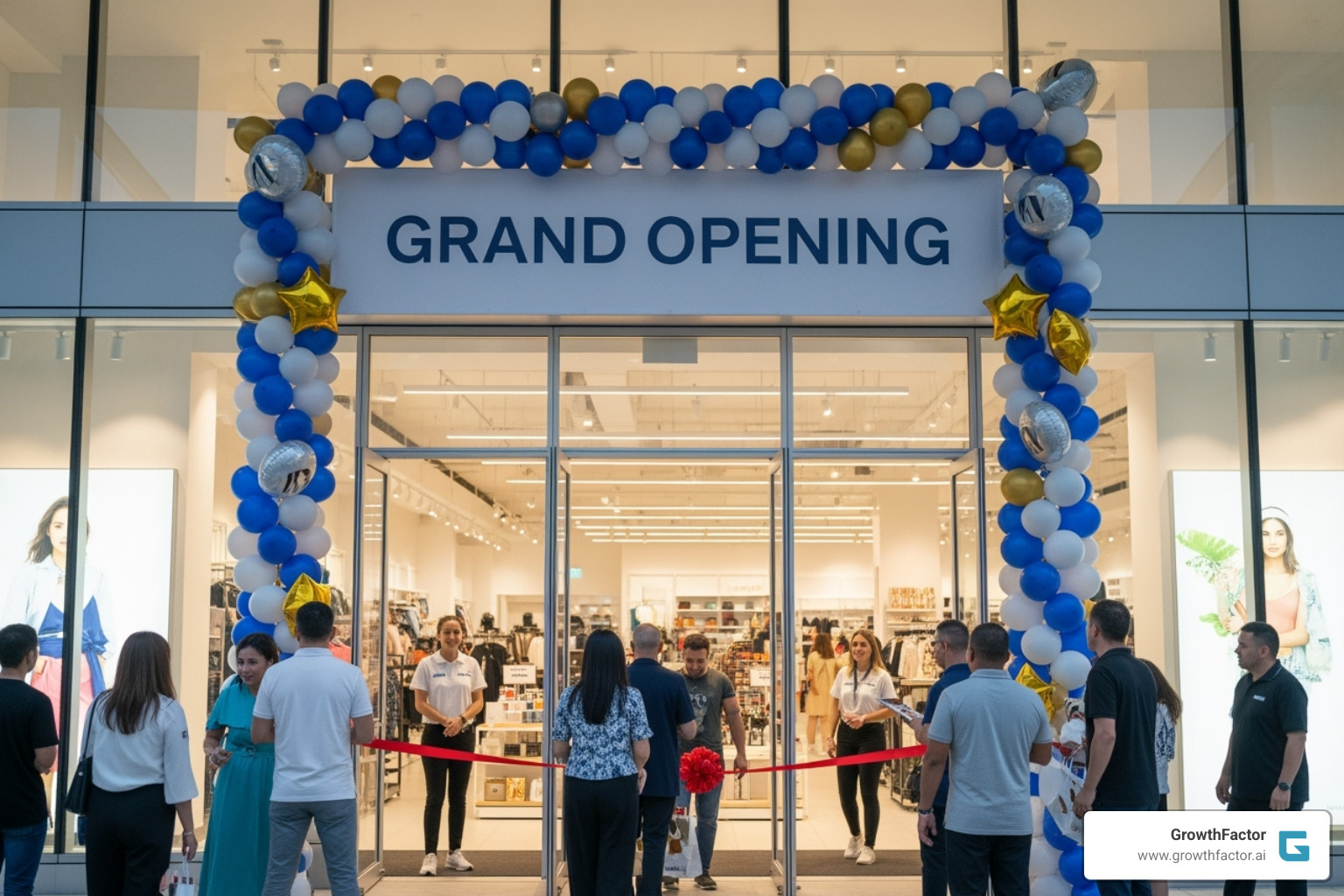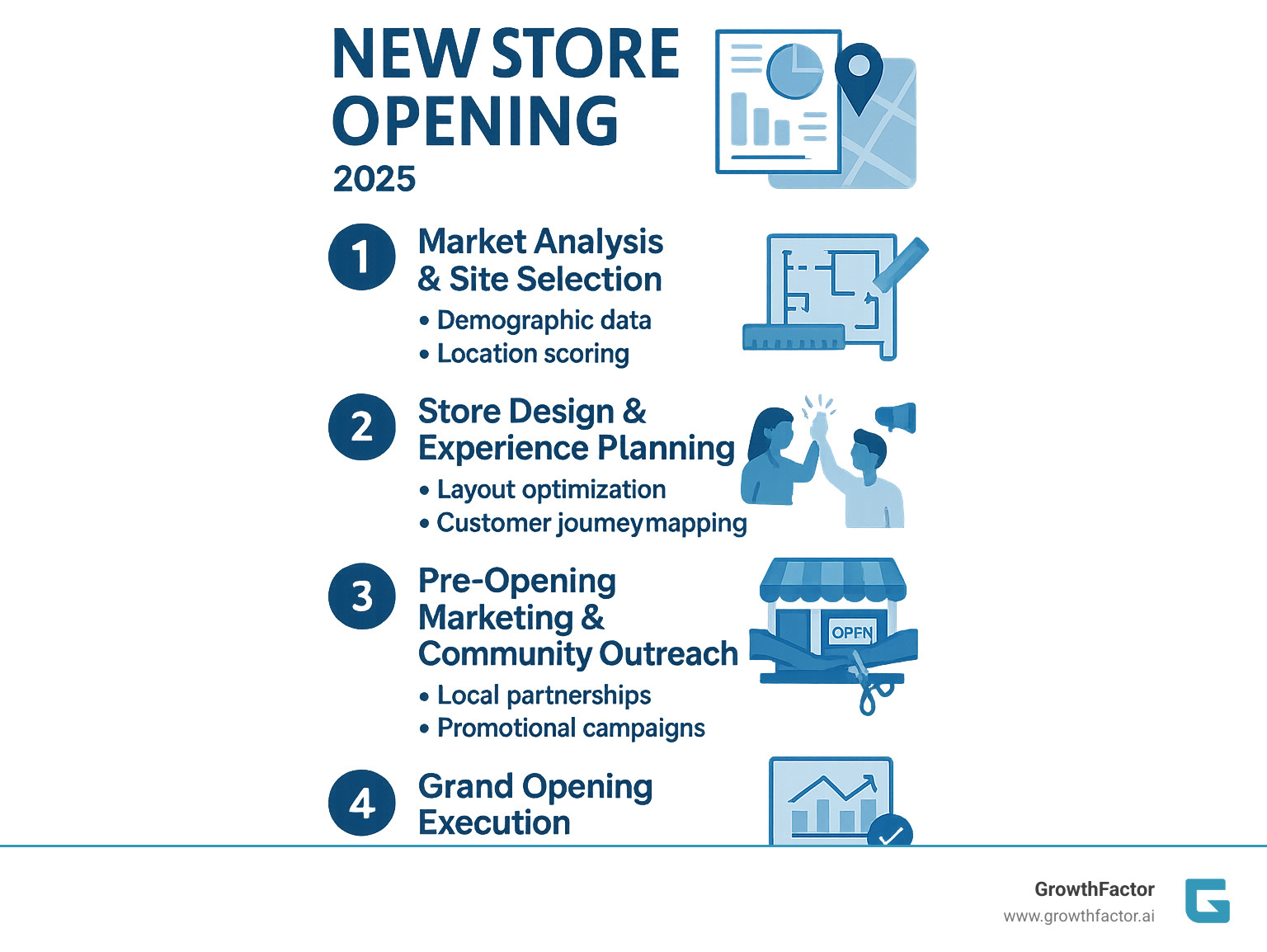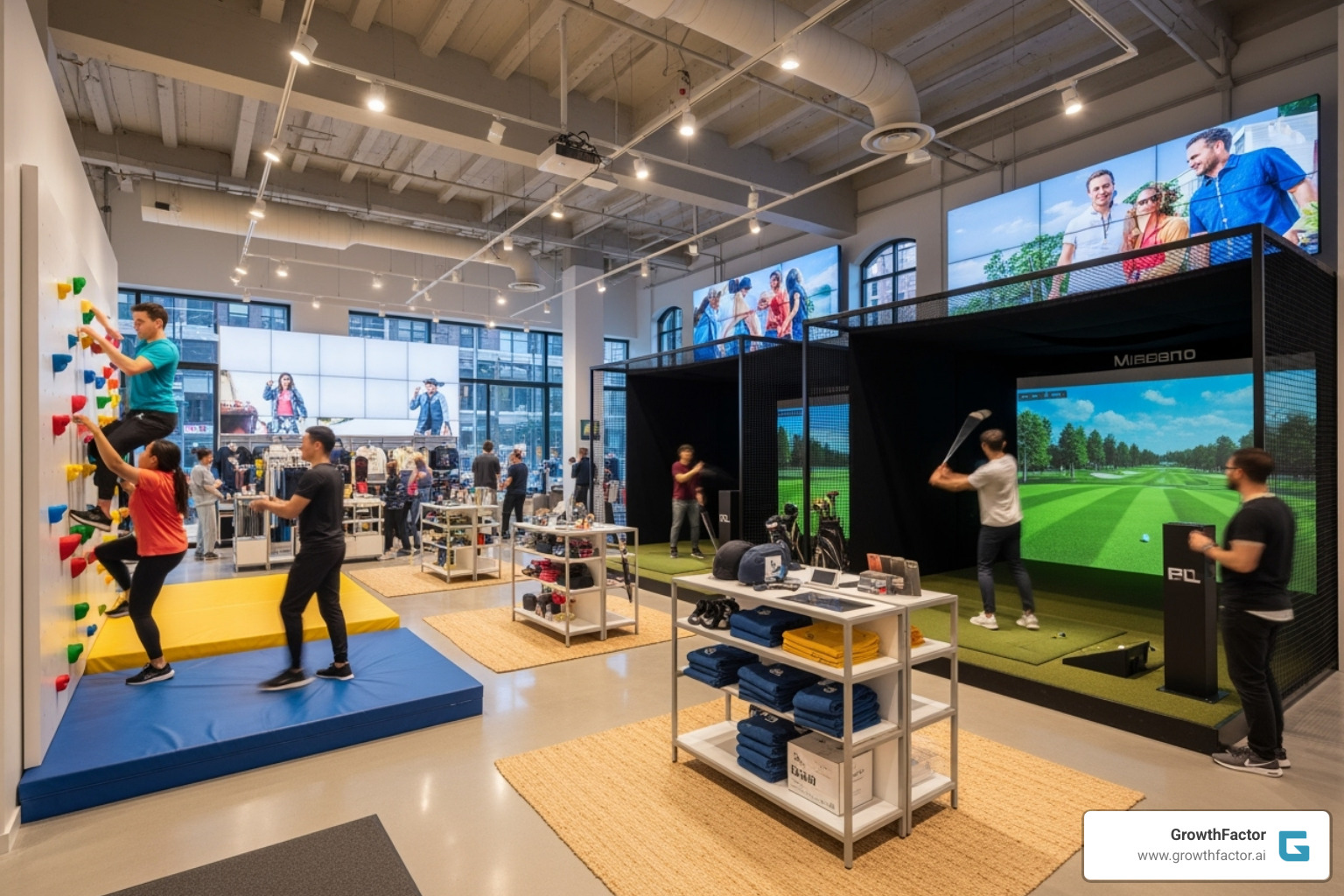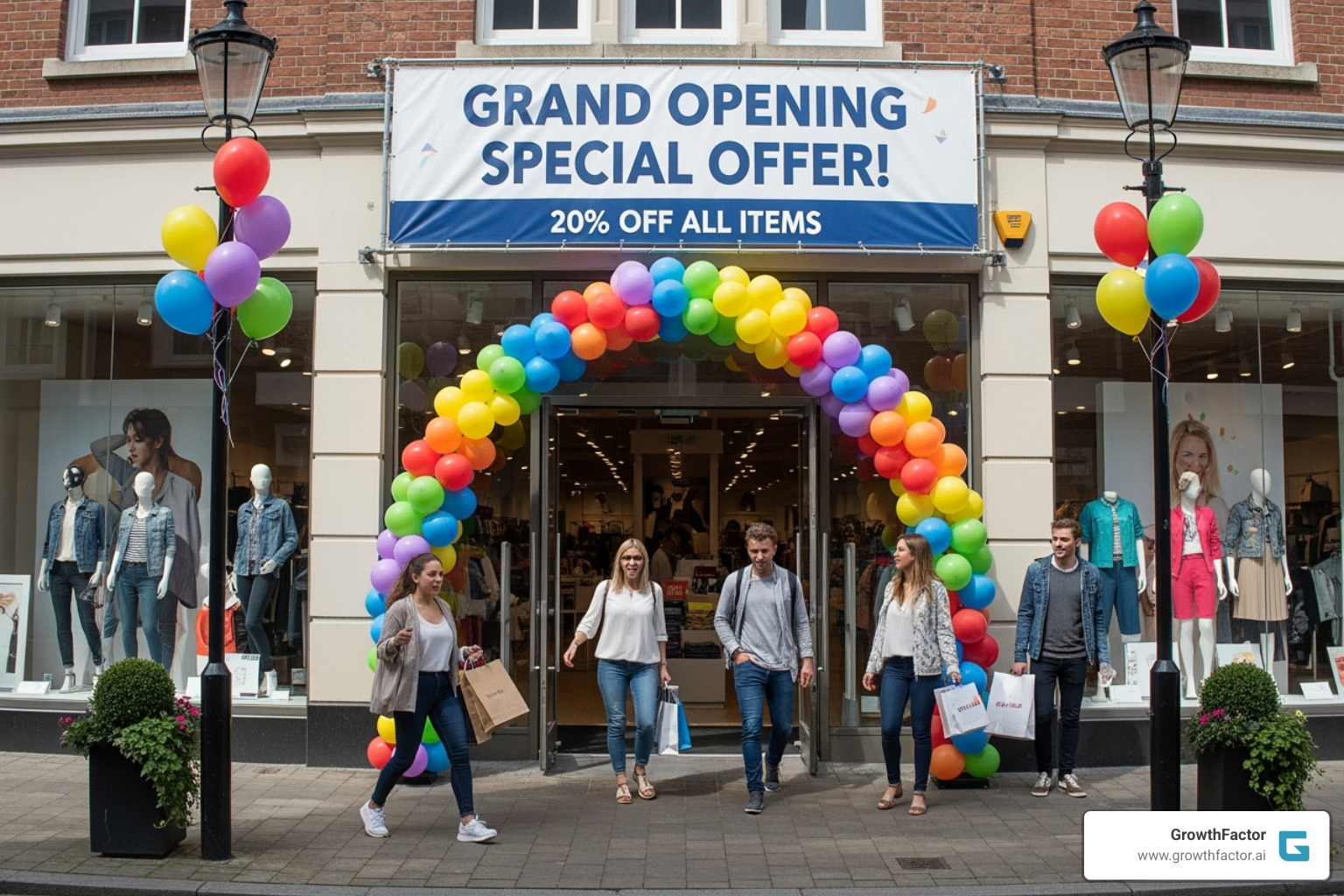Grand Opening Guide: How to Plan a Successful Store Launch in 2025
Written by: Clyde Christian Anderson
The Strategic Reality Behind Every Store Opening

New store opening announcements grab headlines, but the real story begins months earlier. A successful launch involves strategic site selection, community analysis, experiential design, and grand opening events that drive both immediate traffic and long-term loyalty.
Key phases of a new store opening:
- Site Selection - Market analysis, demographic research, and location evaluation
- Store Design - Creating unique experiences that differentiate from online shopping
- Grand Opening Strategy - Launch events, promotions, and community engagement
- Community Integration - Building local partnerships and economic impact
The retail landscape is experiencing a remarkable resurgence. Major chains are expanding aggressively - Dick's House of Sport plans 75 to 100 new concept locations by 2027, while retailers like Target are opening dozens of new stores. Even bookstores are thriving, with Barnes & Noble seeing 14.3% year-over-year visit increases in 2024.
This growth isn't just about finding empty spaces. Today's successful store openings combine data-driven location intelligence with experiential retail concepts that give customers reasons to visit beyond convenience. From Dick's 100,000-square-foot facilities with rock climbing walls to Spirit Halloween's expansion into Christmas retail, retailers are reimagining what a physical store can be.
The stakes are high. A single new store can generate millions in sales tax revenue and create 200+ jobs. But with site evaluation traditionally taking months, growing retail chains need smarter approaches to identify winning locations quickly.
I'm Clyde Christian Anderson, Founder and CEO of GrowthFactor.ai. For over a decade, I've helped retailers steer new store opening challenges, from family retail to developing AI-powered site selection solutions. Our platform has helped clients evaluate over 2,000 locations, achieving 100% success rates on revenue projections for new openings.

The Strategy Behind a New Store Opening
This section explores the comprehensive planning that precedes any ribbon-cutting ceremony, from identifying the perfect location to creating a lasting community impact.
Identifying the Opportunity: Location, Location, Data
Before any construction begins, the most critical decision for a new store opening is its location. It's not just about finding an empty storefront but requires a deep dive into market analysis, community needs, and demographic profiles. The right location can make or break a new venture.
Consider the detailed approach major retailers take. Target, for instance, emphasizes that new store locations are chosen by carefully evaluating "how the company can best meet a community's needs, site constraints, and other area store locations." This isn't guesswork; it's about understanding the surrounding landscape, from population density to the local retail ecosystem. The new Target store in Norwalk, CT, for example, is a substantial 117,215 square feet, indicating a significant investment based on thorough market assessment. Similarly, ALDI's strategic placements, like their Bethpage, NY, store, are a testament to focused location intelligence.
Historically, this process was manual, relying on real estate teams to sift through data. In today's environment, that's not efficient enough. We advocate for leveraging advanced analytics and AI for brick-and-mortar strategy. Many retailers now partner with analytics firms for customized location intelligence and sales forecasting models. This highlights a growing trend: data-driven decisions are replacing intuition.
Our approach at GrowthFactor embodies this evolution. We understand that customer requests influence expansion decisions – thousands of people write in each year asking for stores in their towns. But processing these requests and identifying viable sites requires precision. Our AI-improved platform, powered by AI Agent Waldo, streamlines site selection and deal tracking. This allows real estate teams to evaluate five times more sites efficiently, automating qualification and evaluation. We help you find those prime spots, ensuring your new store opening hits the ground running.
To dig deeper into this critical first step, explore our resources on How to Choose a Retail Location and Data-Driven Site Selection. We help you cut through the noise and pinpoint the perfect spot for your next success.
Crafting the In-Store Experience
Once the location is secured, the focus shifts to designing a captivating store. With online shopping just a click away, a new store opening must offer a unique experience that encourages customers to visit and linger. This is where experiential retail shines.
Consider the ambition of Dick's House of Sport. These aren't just stores; they're destinations. Exceeding 100,000 square feet, they feature rock climbing walls, golf simulators, and outdoor turf fields. This allows customers to test products in unique ways, turning shopping into an interactive experience and creating a memorable impression.

Another fascinating example comes from Japan: the 'Gashapon no Depāto' (Gashapon Department Store). A store opening with 530 capsule toy machines aims to "enrich the 'Gashapon activity'" for fans by offering overwhelming variety and integrating with mobile apps for loyalty points. It's about creating a specialized, immersive world around a niche product.
Even traditional sectors are finding new ways to attract customers. Bookstores like Barnes & Noble and Half Price Books have enjoyed strong year-over-year visitation, proving consumers still crave the "special and irreplaceable reading and browsing experience" of a physical bookstore. It's not just about selling books; it's about providing a place for findy.
Retailers also leverage data to design engaging store environments. From product assortments customized to specific demographics to app-based engagement programs (like Uniqlo's strategy), every element is designed to improve the customer journey. Even a grocery store like ALDI, known for savings, positions itself with exclusive brands and a pricing strategy that makes a visit worthwhile. This thoughtful curation is key to making any new store opening a lasting success.
The Grand Opening: More Than Just Cutting a Ribbon
The grand opening is the culmination of months of planning. It's when a new store opening becomes a vibrant community hub. More than a ribbon-cutting, it's a strategic event designed to generate buzz, drive traffic, and create a lasting first impression.
Retailers make grand openings memorable. ALDI's strategy for their Bethpage, NY, store included a "sneak peek" day, a ribbon-cutting, a chance to win a $500 gift card, and "Golden Tickets" for the first 100 customers. These incentives create excitement and urgency, encouraging early visits.
Nordstrom Rack also leverages gift card sweepstakes on opening day to maximize early traffic. Burlington offers bonus cards and discounts for credit card sign-ups during the grand opening weekend, making the initial visit particularly rewarding.
Beyond discounts, many grand openings become community events. Dick's House of Sport invites local athletes for appearances, turning the opening into a celebration. Sierra's grand opening in Concord, NH, featured a DJ and giveaways, alongside a $10,000 donation to a local environmental organization. This blend of entertainment, promotions, and community engagement transforms a store opening into a significant local happening.

The goal is not just to attract customers on day one, but to build local excitement that endures. By engaging the business community, supporting local events, and offering unique experiences, a new store opening can quickly become an integral part of the neighborhood. It's about creating a party everyone wants to attend, and then ensuring the party continues long after.
The Future of Retail Expansion
As we look ahead, retail keeps changing, shaped by how we shop, new technology, and a fresh appreciation for physical stores. The future of retail expansion is looking bright and full of clever ideas.
The Community Impact of a New Store Opening
A new store opening is more than a place to shop; it breathes economic life into local communities. The ripple effect touches everything from job creation to funding for local services.
One of the biggest immediate impacts is job creation. A single large store, like the Costco in Murfreesboro, can bring over 200 jobs to a town, including management, specialized staff, and support teams, offering diverse career opportunities.
Beyond jobs, new stores bring in important sales tax revenue. That same Costco opening was expected to generate millions in sales tax. This money helps fund local services, maintain roads, and support community programs, providing a huge boost for the city budget.
New stores are also fantastic for community revitalization. When a major retailer like Target moves into a vacant building in Norwalk, CT, it brings the space back to life. This increases foot traffic, making the area more vibrant and often sparking further investment nearby.
What's even better is that new stores often become true community partners. Local business owners, like the couple who opened The Spice & Tea Exchange in Crystal Lake, want to be an "active part" of their town by joining local associations and supporting events. When Sierra donated $10,000 to a local environmental group, it showed a real commitment to local causes. These partnerships help weave the new business into the fabric of the community.
Trends Shaping Future Store Openings
The future of retail isn't just about building more stores; it's about building smarter, more flexible, and more exciting ones. Several key trends are shaping how and where retailers will open their doors next.
One interesting idea is the rise of seasonal retail strategies and pop-up concepts. For example, Spirit Halloween converts some of its locations into "Spirit Christmas" stores for the holidays. This strategy leverages short-term leases to maximize revenue from both the Halloween and Christmas shopping seasons, getting the most out of their physical spaces.

We're also seeing a trend called "rightsizing." This means retailers are not just opening new places but also optimizing their current stores. When one chain closes stores, it opens prime spots for other retailers to move in and reach new customers. It's not just about growth, but about securing the best locations.
Even with the prevalence of online shopping, some physical stores are thriving. Bookstores and craft stores, like Barnes & Noble or Hobby Lobby, are seeing more visitors year after year. They offer a special, hands-on experience you can't get online. People are "voting with their feet" for these "irreplaceable" browsing opportunities.
Making smart choices is key, and that's where advanced analytics and AI come in. Retailers use data to decide where to open, what to sell, and how to run their stores. Our AI Location Intelligence tools are leading the way, giving you the insights to understand changing customer habits and find high-potential spots. This mix of smart planning and data-driven decisions is what makes a successful new store opening of the future.
Navigating the Path to Successful Expansion
Growing a retail business is an exciting but tricky journey, requiring careful planning, a clear vision, and the agility to handle challenges.
Companies like Dick's House of Sport have big plans, aiming for up to 100 new stores by 2027, showing a clear long-term vision. Other retailers might open a few new stores each year, often because customers ask for them. But, as one retailer noted, "Opening dates for new stores are subject to change due to negotiation and approval processes." This points to a common challenge: dealing with paperwork and long waits to secure locations and get approvals.
This is where GrowthFactor steps in. We know finding a great spot is just one piece of the puzzle; managing the entire real estate process smoothly is the other crucial part. Our AI-improved platform is designed to make deal tracking easy, helping your teams manage many potential locations with incredible speed. This not only accelerates the process but also helps avoid expensive delays.
There are many opportunities for growth in retail right now. When some chains close stores, it frees up excellent real estate. Being able to quickly find, evaluate, and secure these locations gives you a huge advantage.
At GrowthFactor, our goal is to empower retail real estate teams to reach their expansion goals with confidence and accuracy. We offer the tools to evaluate five times more sites, automatically check their potential, and make smarter, faster decisions. We believe that with the right technology, every new store opening can be a success story.
Frequently Asked Questions About Grand Openings
What is a grand opening and why does it matter?
A grand opening is a strategic launch event that generates buzz, drives initial foot traffic, and establishes a new store in its community. Beyond ribbon-cutting, successful grand openings include promotions (like ALDI's Golden Tickets for the first 100 customers), community partnerships, and experiential events that create lasting first impressions.
How much does it cost to open a new retail store?
New retail store costs vary widely based on size and market. A single large-format store can require $5-15 million in investment but generate millions in annual sales tax revenue and create 200+ jobs. Key cost factors include lease negotiation, build-out, inventory, marketing, and staffing. Using data-driven site selection reduces risk by ensuring locations meet revenue projections.
How long does it take to plan a grand opening?
Grand opening planning typically begins 6-12 months before launch, with the most intensive work in the final 90 days. Key phases include site selection and lease negotiation (3-6 months), store build-out (2-4 months), pre-opening marketing (60-90 days), and grand opening week execution. Data-driven retailers using AI-powered site selection can evaluate 5x more locations in the same timeframe.
What makes a successful store opening?
Successful store openings combine three elements: strategic location selection based on demographics and traffic data, experiential store design that differentiates from online shopping, and community engagement through launch events and local partnerships. Retailers like Dick's House of Sport see success with 100,000+ sq ft experiential destinations, while bookstores like Barnes & Noble thrive by offering irreplaceable browsing experiences.
How do you choose the best location for a new store?
Optimal store locations are identified through data-driven analysis of demographics, foot traffic, competition, and sales potential. Modern retailers use AI-powered site selection platforms like GrowthFactor to analyze thousands of potential sites, test cannibalization scenarios, and forecast sales with 99.8% accuracy. This replaces months of manual analysis with insights available in minutes.
To learn more about how we can help you on your expansion journey, check out our insights on Retail Store Expansion Strategy. And if you're ready to see how AI can change your real estate operations, we invite you to Learn how AI can streamline your site selection process. We offer three plans: Starter ($200/mo) for growing retailers with fewer than 10 locations, Core ($1,000/mo) for expanding retailers with 10+ locations, and Enterprise (custom pricing) for large organizations. Let's build your future, one amazing new store opening at a time!
Citations
The human algorithm
Request Your demo
Schedule meeting
Or submit your information below and we'll be in touch to schedule.


